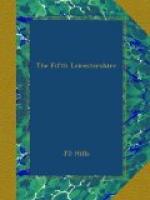Border Redoubt and Rats’ Creek were the hunting ground of “B” and “D” Companies, and here Lieuts. Ball and Measures more than once nearly captured a Boche post. But the enemy was too alert, and slipped away always down some tunnel or deep dug-out. But the best patrolling was done from Russian Sap, by 2nd Lieut. Cole and his gang from “D” Company, including Serjt. Burbidge, Cpl. Foster, L/Cpl. Haynes, Ptes. Thurman, Oldham and others. They had very bad luck, for on two occasions they lay in wait for the enemy in his own front line and he never came, though he had occupied the post the previous night, and the party, wet through and frozen, had to return empty handed except for a bomb or two.
There was one other unusual occurrence before we left the St. Elie sector. We were visited one day by a local newspaper reporter, Mr. Wilkes of the “Leicester Mail,” who came to see us in trenches, and was introduced to the tunnels and all the “grim horrors” of trench warfare. It seemed curious to see a civilian in a grey suit, adorned with a steel helmet and box respirator, wandering about the communication trenches.
On the 14th of November, while in Brigade Support at Philosophe, we were ordered to reconnoitre the “Hill 70” sector, with a view to taking over the line from the Sherwood Foresters. The same day we moved to some particularly cold and uncomfortable huts at Mazingarbe, going to the line the next night. Our route lay along the main Lens road past Fosse III. and Fosse VII., then by tracks past Privet Castle to Railway Alley. This endless communication trench led all the way past the famous Loos Crucifix, still standing, to what had been the front line before the Canadian attack. Thence various other alleys led to the front line. Our new sector was by no means luxurious. There was a front line trench and portions of a reserve line, all rather the worse for wear, while the communication trenches, “Hurrah” and “Humbug” Alleys, were unspeakably filthy. The whole area at the top of the hill was an appalling mess of tangled machinery from Puits 14 bis, battered trenches, the remains of two woods, Bois Hugo and Bois Raze, and shell holes of every size and shape. There was mud and wet chalk everywhere, and a very poor water supply for drinking purposes. What few dug-outs existed were the usual small German front line post’s funk holes, and all faced the wrong way. It was a bad place. There was, however, one redeeming feature. From the hill we could see everything, Hulluch, Wingles, Vendin and Cite St. Auguste lay spread out before us; we could see the slightest movement. Behind the hill, Support Companies were out of sight, and those not actually in the front line could almost all wander about on top without fear of being seen. Furthermore, there were no tunnels. We spent all our time working, for there was much to be done. Our chief tasks were clearing out existing trenches and digging new communication trenches where they were wanted.




